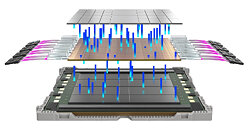
TSMC Unveils Next-Generation A14 Process at North America Technology Symposium
TSMC today unveiled its next cutting-edge logic process technology, A14, at the Company's North America Technology Symposium. Representing a significant advancement from TSMC's industry-leading N2 process, A14 is designed to drive AI transformation forward by delivering faster computing and greater power efficiency. It is also expected to enhance smartphones by improving their on-board AI capabilities, making them even smarter. Planned to enter production in 2028, the current A14 development is progressing smoothly with yield performance ahead of schedule.
Compared with the N2 process, which is about to enter volume production later this year, A14 will offer up to 15% speed improvement at the same power, or up to 30% power reduction at the same speed, along with more than 20% increase in logic density. Leveraging the Company's experience in design-technology co-optimization for nanosheet transistor, TSMC is also evolving its TSMC NanoFlex standard cell architecture to NanoFlex Pro, enabling greater performance, power efficiency and design flexibility.
Compared with the N2 process, which is about to enter volume production later this year, A14 will offer up to 15% speed improvement at the same power, or up to 30% power reduction at the same speed, along with more than 20% increase in logic density. Leveraging the Company's experience in design-technology co-optimization for nanosheet transistor, TSMC is also evolving its TSMC NanoFlex standard cell architecture to NanoFlex Pro, enabling greater performance, power efficiency and design flexibility.

























